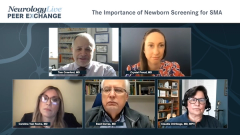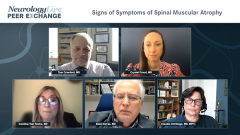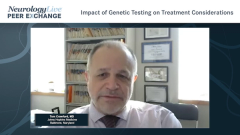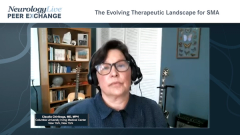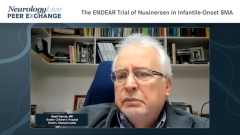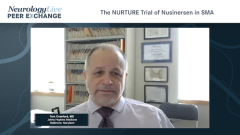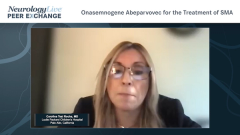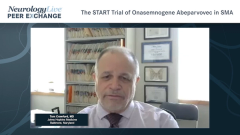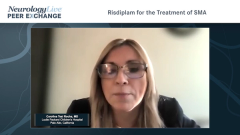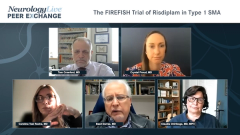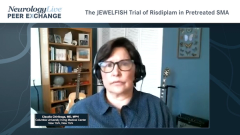
The ENDEAR Trial of Nusinersen in Infantile-Onset SMA
Basil Darras, MD reviews data from the ENDEAR trial of nusinersen in infantile SMA and discusses the agent’s safety and efficacy in patients of differing age groups as studied in other trials.
Episodes in this series

Crystal Proud, MD: Actually, this is a nice segue; let’s talk about the approval of nusinersen with the ENDEAR trial. Basil, hopefully you can walk us through the importance of this trial and some of the data that came along with it.
Basil Darras, MD: Sure; I would be happy to, Crystal. The ENDEAR study compared nusinersen versus sham control when treating infantile-onset spinal muscular atrophy [SMA]. Basically, we are talking about babies with type 1, or 2 copies of the SMN2 gene, between 1 and 6 months of age. It was randomized, if you remember, it was 2:1. It was a double-blind, sham-controlled, phase 3 efficacy and safety trial. Now, “sham control” means there was a group of patients who actually did not receive the medical treatment. They did not even have a lumbar puncture; rather, they had a sham procedure, but with the exception of a few people, the rest of the research teams were blinded. As time went on, of course, given the efficacy, the blinding was not 100%. In any case, the primary end points were a motor milestone response, defined by the results of the Hammersmith Infant Neurological Examination, and event-free survival, defined as time to death or use of permanent ventilation for more than 16 hours per day, for 4 weeks. There were also secondary end points, which included survival and a few other points. In the interim analysis that was conducted, I think in the summer of 2016, a significantly higher percentage of infants who received nusinersen had achieved a motor milestone response: 41% of infants who received nusinersen achieved it versus 0% in the sham control group.
At the end of this study, the numbers were 51% versus 0%. The babies who received the medication acquired motor milestones, including head control, sitting, and so on. As everybody knows, babies who have SMA type 1, by definition, never sit unassisted or independently. They also looked at the likelihood of event-free survival, which was much higher in the group of patients taking nusinersen. Another important finding was that the babies who were treated within 12 weeks—when the duration was less than 12 weeks—did much better than the babies who were treated after 12 weeks. This underscores the importance of early treatment. This is a summary of the ENDEAR study, but there are also other studies. The ENDEAR study was proceeded by the CS1 and CS2 studies, and so on. These were open-label studies, and there was also a study known as CHERISH that examined the safety and efficacy of nusinersen in patients with later-onset SMA. When the results of this study were presented to the FDA, approval was granted in December of 2016. So far, we have been treating many patients with nusinersen. I think the number of patients being treated is more than 11,000; more than 3000 adults have also been treated with nusinersen.
It seems to be safe, outside of the lumbar puncture adverse events, or events that have to do with postural pain syndromes and headaches. Outside of that, nusinersen seems to be quite safe because you infuse the medication into intrathecal space. It stays in there, and only about 1% leaks into stem circulation. It was approved for all types of SMA, regardless of the patients’ age, and it seems that people do benefit. When we look at the long-term results—up to about 3 years—it became clear, now with a 5-year follow-up—when you look at the different ages, it seems that the patients who had the best response were between the ages of 2 and 3.5 years old. Between the ages of 3.5 and 5, patients had some response and stabilization. In the older group, there was stabilization. But stabilization is also a desirable outcome in SMA because, as everybody knows, if you follow these patients over time, they do lose function. They lose function every year. Everybody can benefit, but if you look at adult patients, the results are not very impressive, in my opinion. We have to think, however, that there are adults who are able to use only a finger to drive their wheelchair. A patient might say, “If I lose the ability to drive my wheelchair, it would be a catastrophe for me.” Even maintaining that degree of function is, for many people, very important.
For the patients themselves, it is very important, but there are adults who are happy with the disease. They have been stable for many years, and they do not want to have the lumbar puncture done once every 4 months. This is why many adults do not want to be treated yet and there are also insurance barriers. It is given intrathecally, as I said. You remove 5 mL of CSF [cerebrospinal fluid] and you inject 5 mL of the drug, which contains 12 mg of nusinersen, intrathecally over a few minutes. It is an outpatient procedure. As I said, the safety profile seems to be good so far. We have treated many patients, and in the most recent abstract that has been presented, the retention rate was about 90% pre–COVID-19. That is what we know about nusinersen so far. It has been used to treat babies who were found to have SMA because of the implementation of newborn screening.
Crystal Proud, MD: Thank you for watching this NeurologyLive® Peer Exchange. If you enjoyed the content, please subscribe to our e-newsletters to receive upcoming Peer Exchanges and other great content right in your inbox.
Transcript Edited for Clarity
Newsletter
Keep your finger on the pulse of neurology—subscribe to NeurologyLive for expert interviews, new data, and breakthrough treatment updates.

